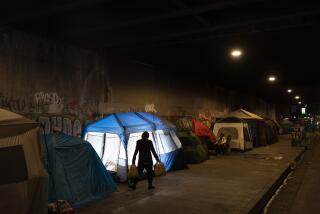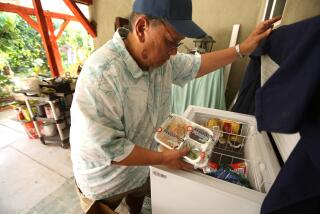Volunteer’s Aim: ‘Keep Everybody Else Out of the Garbage Can’ : Activist: Bea Gaddy remembers when times were bad for her. Now she operates a food pantry, shelters for homeless women and programs for drug addicts.
- Share via
BALTIMORE — On a frigid day this winter, Bob Newport showed up at Bea Gaddy’s door.
Work had been scarce for Newport, a construction worker. Money was scarce too.
He was hungry.
“Any time I am hungry or cold or in need of a meal, I know where I can go,” said Newport as he eyed his second bowl of soup.
He is not alone. For the homeless and poor in Baltimore, Bea Gaddy is an urban beacon.
From her humble row house crammed with used clothing and surplus food, she operates a food pantry. She also has established shelters for homeless women. She runs a program that will provide homes and training for drug addicts. Her latest endeavor is a program for early diagnosis of inner-city children poisoned by lead paint.
Gaddy, 58, has survived a long, slow resurrection from poverty. Now, she is trying to take others with her. Born into poverty, reared amid a sense of homelessness, Gaddy once had to find her meals in garbage cans. Now, the driving force in her life is “to keep everybody else out of the garbage can.”
The crown jewel of Gaddy’s labors comes at Thanksgiving. Since 1981 she has arranged Thanksgiving meals for the needy. That year, she fed 16 people; last year, nearly 10,000 had a hot meal through her efforts.
Those who come to Gaddy’s door get a meal, clothes, a place to stay, but perhaps most important, a kind word. Volunteers are cautioned that even if the cupboards are bare, no one is turned away with an abrupt no.
Called “Shorty” by her volunteers, the 5-foot-3 Gaddy greets visitors with the warmth of newly baked corn bread. Volunteers swirl through her kitchen, cooking the food that will be served in her shelters and the food pantry.
From the stove comes the wickedly delicious aroma of fried chicken, drenched in flour and herbs and simmering in a bubble bath of hot oil. Amid the cheerful chaos, Gaddy exhibits a mixture of spunk, authority and homespun graciousness that belies a firm hand.
“She’s tough,” says Angela Stokes, who has stayed in Gaddy’s women’s shelter. “There are rules, strict rules. But you appreciate it after everything is over with.”
Easing hunger is a crusade fed by Gaddy’s personal experience. The great-granddaughter of a slave, Gaddy grew up in poverty in Wake Forest, N.C. Her stepfather inflicted punishment by withholding food, she says.
He also would remind Gaddy and her siblings that they were not his children. That left her with the feeling that she never really had a home.
“Sometimes, it’s hard to talk about. My mother had to send my oldest brother away to live with relatives, because he was so mean to him. Sometimes he would get drunk and get us out of the bed in the middle of the night, and he used to chase us up the street,” she said, her voice betraying a whisper of her Southern roots.
On a recent trip back home, a childhood friend reminded her how they eased the hunger in their bellies.
“He said: ‘Can you remember running to the garbage cans?’ We would get together to see which had the best food,” she recalls.
Gaddy married her first husband at age 22 on a lark.
“The reason I married him is that he had a job,” she says.
The marriage had no chance. The couple had two children and separated. Gaddy moved to New York with her brother and his wife in 1953.
“We slept in the car the first night because we had nowhere to go. We then stayed with an uncle for two days. We found a place: My brother and his wife and I all shared one room,” she recalls.
Her first husband was later shot and killed in North Carolina.
She found work as a live-in domestic and worked part time at other housekeeping jobs. She also had three more children by a former boyfriend in North Carolina. On weekends, she would return there to visit all five youngsters.
Gradually, her attitude and work suffered, she said, and in 1964 she lost her job. Although she had some family in New York, she did not feel welcome there. So for two days, she lived in a bus station.
“I was scared, but it wasn’t so bad because I never did have a home anyway, I just had a roof over my head,” she says.
She remembered a friend in Baltimore. She called him, and he got her a ticket to come here.
“I often wonder what would have happened to me if I didn’t make that phone call,” she says, brushing her hand through her graying black hair.
Her friend helped her settle into a small house furnished with secondhand furniture. She brought her children to live with her and trained as a nurse’s aide, but she had to quit her job to care for them. If day-care programs existed, she said, she didn’t know about them.
She went on welfare and found that the money didn’t go far enough. The family went one winter without heat or electricity.
“We would eat pigs’ feet and collard greens, not because we liked them, but because that is what we could afford,” she recalls. “That winter, I bought an ice chest and a tin stove, where I would cook our food. We had lamps lit by kerosene.”
To find food, she relied on a childhood skill: She looked through garbage cans.
“The Kentucky Fried Chicken garbage always had the best food. I used to think that this was so shameful. But if you’re hungry there is nothing that you have to be ashamed of,” she says.
She credits attorney Bernard Potts with persuading her that she could do more with her life. At the time, she was working as a school crossing guard at an intersection near his law office. Potts convinced the high-school dropout that she was college material.
“I saw she had the capacity, but she didn’t know it. She said to me, Who me? like I was telling her to climb Pike’s Peak,” says Potts, who now serves on the board that oversees the effort.
With his encouragement, she enrolled at a special program at Antioch College in 1975 and earned a bachelor’s degree in human services in two years.
“I worked as a human service aide with the city department of social service during the day and went to school at night,” she said. “It was hard. I got up at 6 in the morning, I’d be home at 7 at night. I’d fix dinner, I had someone watch the children and go to school and I’d be back at 11 o’clock at night.”
Gaddy, who married her second husband, Lacy Gaddy, in 1979, continued working for the city until the program under which she was hired was discontinued in 1980.
In 1981, when federal aid to the poor was slashed, Gaddy knew that would devastate her inner-city neighborhood.
She decided to open a food pantry.
Rolling a wheeled garbage container, she made the rounds of local grocers, asking for the food they usually threw away. Her first stop was a Korean grocer. She went to him afraid, mindful of the friction that sometimes erupts between Koreans and blacks in inner-city areas.
“I said: ‘Sir, can we have the food you are going to throw away so we can eat it tonight?’ ” she recalls. “He said: ‘What did you say?’ I said: ‘Sir, can we have the food you are going to throw away so we can eat it tonight?’ ”
“He said: ‘OK.’ He kept filling it up and filling it up and filling it up,” she says.
She operated the pantry out of her apartment where she was living, but knew she needed something larger.
‘I went to the city to request a building. From there, different people put me in touch with different people. I think I must have had God there with me, because people and organizations began to ‘adopt’ me.”
The result was her “mother” organization: the Patterson Park Emergency Food Center, which provides food and emergency assistance for rent and utilities. It spawned five other grass-roots programs.
The Bea Gaddy Social Development Center operates a shelter for homeless women and children.
“We can hold 30 women, but we’ve had up to 49,” she says.
The Bea Gaddy Trust is revitalizing 11 houses, which will serve as homes for chemically-dependent women.
“One thing we try to teach them is how to be neighbors to each other, teach them how to settle their differences without fighting,” she says.
She also operates a business training institute, in cooperation with Fawn Industries, IBM and Catonsville Community College. She also oversees a drug prevention program and a program to detect lead poisoning in inner-city youngsters.
All survive on donations. The city of Baltimore provided about $95,000 to renovate the women’s shelter and $79,400 over the last two years in operating funds.
Gaddy lives on money she receives boarding a woman who was deinstitutionalized several years ago. She said she also draws a salary as director of the women’s center. The center is having financial problems, she says, because a former bookkeeper mishandled some funds. She says she and members of the board are trying to correct the problems.
In 1981, she decided to share $290 from a hit on the state lottery by providing a Thanksgiving meal for 16 needy people.
Last year, with donated food and volunteer help, she organized a meal for 9,412 families. The meals were served under a tent on a city street closed for the day. Last year, inmates from the state penitentiary helped do the cooking, and 300 volunteers helped serve.
“I tell the volunteers not to take their coats off, because it might be given away,” she says.
More to Read
Sign up for Essential California
The most important California stories and recommendations in your inbox every morning.
You may occasionally receive promotional content from the Los Angeles Times.






